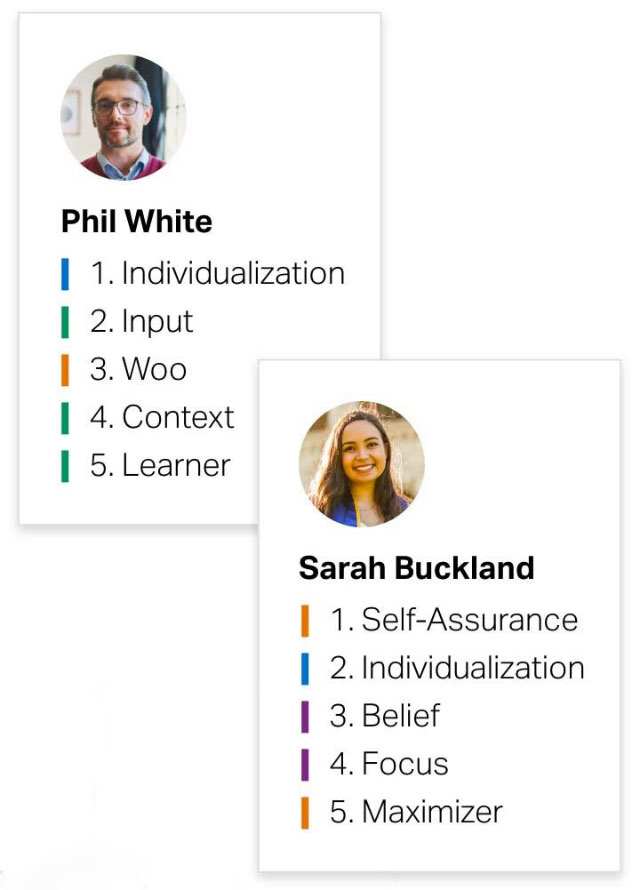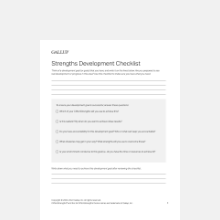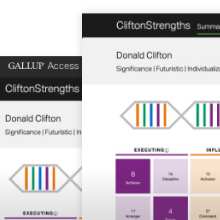
How to Develop and Improve Your Strengths
Discover your strengths. Then learn how to develop them into something you can depend on at work, at home and in every relationship -- time and time again.
Do you know your strengths? Discover which CliftonStrengths report is right for you, and take the assessment today.
- 1Development never ends -- why that's good news.
- 2You know your strengths. Now what? Discover strengths-based development.
- 3Moving to the next level, personally and professionally.
- 4Ways you can use your strengths (with a free checklist activity).
- 5Every resource you need to increase your strengths success.
1. Lifelong Development Starts With Strengths
Self-awareness is the first step in development. You cannot develop what you don't know you have.
And as your self-awareness grows, so do your opportunities to develop.
For as long as you work, grow relationships, strategize, complete goals (big and small), and influence those around you, you will have the chance to deepen your awareness of your strengths. You'll thrive as you continue to grow in meaningful ways.
Here's what we know.

2. Strengths-Based Development Leads to True Success
Your strengths give you your cutting edge. They're the difference between good and great. They're obvious enough to set you apart, yet versatile enough for you to shape and develop them into your secret advantage.
Yet they never stop growing and adding value to your life. How? Because we know that what it takes to turn your talents into strengths is simply investment. And investment never ends.
We use an equation to help others understand and grow their talents:
Talent x Investment = Strength
Let's break these down:

Talent is a natural way of thinking, feeling or behaving.
Investment is time spent practicing, developing your skills and building your knowledge base.
Strength is the ability to consistently provide near-perfect performance in a specific task.
This method for development isn't our best guess for how to turn your talents into strengths -- it's a proven way to help you succeed.

Our data show that people who have the opportunity to use their CliftonStrengths are:
6x as likely to be engaged in their job
6x as likely to strongly agree that they have the chance to do what they do best every day
3x as likely to report having an excellent quality of life
Work engagement? Higher quality of life? Doing more of what you're great at? These outcomes just scratch the surface. People are also more likely to achieve their goals and be more confident. Finally, while people's personal experiences could point to hundreds of positive outcomes...
CliftonStrengths users are more likely to report:
- having ample energy
- being happy
- being treated with respect
And less likely to report experiencing:
- xworry
- xstress
- xsadness
- xanger
Using your strengths -- really keeping them in mind every day -- can quite literally change your life for the better.
Action Item
Starting today, try the talent equation listed above. List your CliftonStrengths themes (talents) in a column; then, next to each one, list ways you can develop them. Really think about your daily tasks, conversations and routines. What can you do to develop your strengths in those moments?
3. Develop Your Strengths Personally and Professionally With Better Goals
Here's something to consider: Personal development goals and professional development goals are just ideas that don't become goals until you've found a way to incorporate your strengths. A goal without a plan causes more stress than success.
Before you set goals, check out this resource to learn how to set and achieve them using your CliftonStrengths. But for smaller or more task-like development opportunities, start by laying out your areas of focus; then consider how you'll develop them.

Identify areas in which you'd like to develop personally:
- in your friendships
- creating a better morning or evening routine
- taking more time to read
- implementing a health or wellness goal
Do the same professionally, identifying areas you'd like to develop:
- building a better work-from-home routine
- changing career paths or pursuing a new position in your organization
- coursework or certifications you'd like to complete
- role-related skills you'd like to learn
Then, decide which of your strengths you'll use to do each of those things. You can use more than one!
Finally, refer to the strengths equation (talent x investment = strength) as a model. What daily tasks and outcomes should you achieve to make sure you're successful in your goal?
Be realistic about how you'll invest in these areas, and have plenty of patience with yourself as you find the best way to do that.
Here are some resources for those who want to develop in these areas:

As a Leader
- Leadership traits: What makes a good leader
- The most effective leadership styles
- Leadership development

In Your Career
- What you should look for in a career
- Finding fulfillment in your career
- Career coaching using your strengths

On a Team
- Conversations that improve teamwork
- Effective team collaboration
- Team building activities
Should We Talk About Weaknesses?
With so much talk about strengths, people often wonder, "What about my weaknesses? Should I just ignore the things I'm not great at?" Whether they're daily tasks, relationships that drain you or things that are just hard for you to do, the answer is no. We should not ignore our weaknesses. Because, truthfully, most people don't have the luxury of turning a blind eye to those challenges.
Here's what Don Clifton, inventor of the CliftonStrengths assessment, had to say about it:

"There is no alchemy for weakness. They can be removed but they cannot be transformed into strengths. The goal, therefore, is to manage weaknesses so the strengths can be freed to develop and become so powerful they make the weaknesses irrelevant." -- Don Clifton, Soar With Your Strengths
So, how do you develop your strengths, manage your weaknesses and shift your focus to what you're good at?
Consider one of your weaknesses and see the action item below.
Action Item
- Reframe your weakness in terms of your strengths (which strengths will help you with this?). or
- Partner with someone else for help.
4. Personal Growth and Development: Ways to Use and Aim Your Strengths
How you use your strengths will vary based on your role, routine, experiences and so much more. Each of the 34 themes is categorized into one of four domains: influencing, executing, relationship building and strategic thinking. Here are some ideas, by domain and theme, on how you could productively aim your strengths.
Strategic Thinking
A fundamental need for strategic thinking themes is the time and space to think. To truly develop these themes, you'll need to make sure you consider time as a factor. Block out time on your calendar. Consider allotting 15 minutes in the morning or before bed - whatever you need to allow your mind to do all that it's capable of.
Analytical ● Context ● Futuristic ● Ideation ● Input ● Intellection ● Learner ● Strategic
Relationship Building
Developing or aiming your relationship building themes works best in the presence of others. This may sound obvious, but it's a critical detail that can be overlooked. If you start prioritizing tasks, deadlines, routines or structures over relationships, these themes will feel underfed. Consider your natural desire and need for high-quality relationships - and invest in them.
Adaptability ● Connectedness ● Developer ● Empathy ● Harmony ● Includer ● Individualization ● Positivity ● Relator
Influencing
Challenging your confidence is key to developing your influencing themes. Make sure you're taking a step back to consider how you're using these themes to help those around you. Are you giving a platform or voice to a specific person or audience? One of the best ways to develop themes in this domain is to put yourself in new situations where you're forced to shine bright in new, unfamiliar ways.
Activator ● Command ● Communication ● Competition ● Maximizer ● Self-Assurance ● Significance ● Woo
Executing
When developing your executing themes, you'll need to focus on the quality of the work you're doing, not just the quantity. Whether at home or work, it may be hard for you to determine which tasks are essential and which are nonessential. Getting things done is your forte - make sure you develop these themes by investing in your ability to prioritize so you can contribute your best.
Achiever ● Arranger ● Belief ● Consistency ● Deliberative ● Discipline ● Focus ● Responsibility ● Restorative

Action Item
Download this free activity to see how you can immediately start developing your strengths. Whether you're a strengths beginner or consider yourself an expert -- here are some great ideas.
5. Now, Develop Your Strengths With These Resources

CliftonStrengths PodcastCheck out the CliftonStrengths podcast for our latest development content. Learn how to aim your strengths and live with your strengths in mind. Listen wherever you listen to podcasts.

CliftonStrengths Insights NewsletterDevelop your strengths with just 10 minutes of reading each month. Subscribe to the CliftonStrengths Insights newsletter to see our latest articles, videos, reports and personalized strengths content.

Free Checklist ActivityLooking for a way to exercise your strengths? Download this free checklist activity to see how you can aim your strengths toward your goals.

Role-Based CliftonStrengths ReportsDiscover your CliftonStrengths or add another report so you can learn to develop in new and specific ways. See if any of our role-based reports are right for you.

